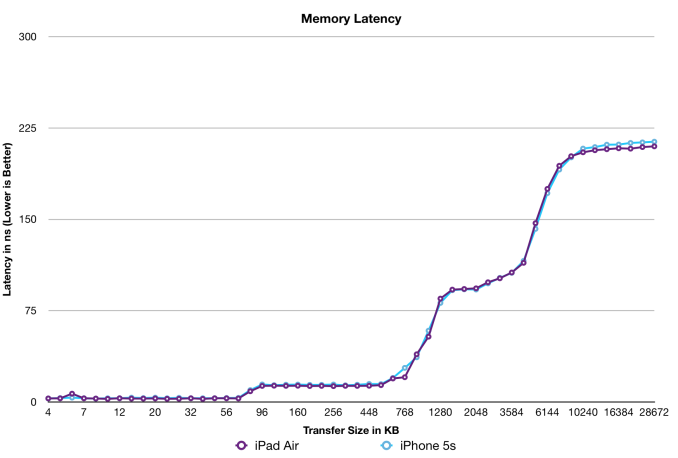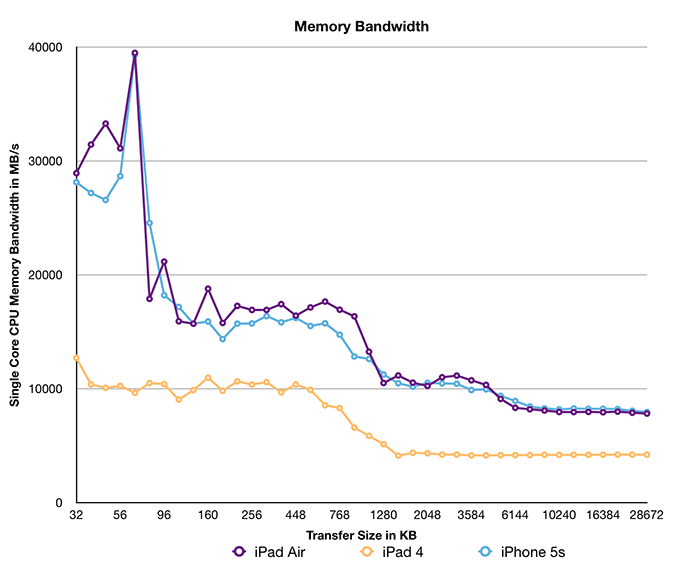The iPad Air Review
by Anand Lal Shimpi on October 29, 2013 9:00 PM ESTAn Update on Apple’s A7: It's Better Than I Thought
When I reviewed the iPhone 5s I didn’t have much time to go in and do the sort of in-depth investigation into Cyclone (Apple’s 64-bit custom ARMv8 core) as I did with Swift (Apple’s custom ARMv7 core from A6) the year before. I had heard rumors that Cyclone was substantially wider than its predecessor but I didn’t really have any proof other than hearsay so I left it out of the article. Instead I surmised in the 5s review that the A7 was likely an evolved Swift core rather than a brand new design, after all - what sense would it make to design a new CPU core and then do it all over again for the next one? It turns out I was quite wrong.
Armed with a bit of custom code and a bunch of low level tests I think I have a far better idea of what Apple’s A7 and Cyclone cores look like now than I did a month ago. I’m still toying with the idea of doing a much deeper investigation into A7, but I wanted to share some of my findings here.
The first task is to understand the width of the machine. With Swift I got lucky in that Apple had left a bunch of public LLVM documentation uncensored, referring to Swift’s 3-wide design. It turns out that although the design might be capable of decoding, issuing and retiring up to three instructions per clock, in most cases it behaved like a 2-wide machine. Mix FP and integer code and you’re looking at a machine that’s more like 1.5 instructions wide. Obviously Swift did very well in the market and its competitors at the time, including Qualcomm’s Krait 300, were similarly capable.
With Cyclone Apple is in a completely different league. As far as I can tell, peak issue width of Cyclone is 6 instructions. That’s at least 2x the width of Swift and Krait, and at best more than 3x the width depending on instruction mix. Limitations on co-issuing FP and integer math have also been lifted as you can run up to four integer adds and two FP adds in parallel. You can also perform up to two loads or stores per clock.
I don’t yet have a good understanding of the number of execution ports and how they’re mapped, but Cyclone appears to be the widest ARM architecture we’ve ever seen at this point. I’m talking wider than Qualcomm’s Krait 400 and even ARM’s Cortex A15.
I did have some low level analysis in the 5s review, where I pointed out the significantly reduced memory latency and increased bandwidth to the A7. It turns out that I was missing a big part of the story back then as well…
A Large System Wide Cache
In our iPhone 5s review I pointed out that the A7 now featured more computational GPU power than the 4th generation iPad. For a device running at 1/8 the resolution of the iPad, the A7’s GPU either meant that Apple had an application that needed tons of GPU performance or it planned on using the A7 in other, higher resolution devices. I speculated it would be the latter, and it turns out that’s indeed the case. For the first time since the iPad 2, Apple once again shares common silicon between the iPhone 5s, iPad Air and iPad mini with Retina Display.
As Brian found out in his investigation after the iPad event last week all three devices use the exact same silicon with the exact same internal model number: S5L8960X. There are no extra cores, no change in GPU configuration and the biggest one: no increase in memory bandwidth.
Previously both the A5X and A6X featured a 128-bit wide memory interface, with half of it seemingly reserved for GPU use exclusively. The non-X parts by comparison only had a 64-bit wide memory interface. The assumption was that a move to such a high resolution display demanded a substantial increase in memory bandwidth. With the A7, Apple takes a step back in memory interface width - so is it enough to hamper the performance of the iPad Air with its 2048 x 1536 display?
The numbers alone tell us the answer is no. In all available graphics benchmarks the iPad Air delivers better performance at its native resolution than the outgoing 4th generation iPad (as you'll soon see). Now many of these benchmarks are bound more by GPU compute rather than memory bandwidth, a side effect of the relative lack of memory bandwidth on modern day mobile platforms. Across the board though I couldn’t find a situation where anything was smoother on the iPad 4 than the iPad Air.
There’s another part of this story. Something I missed in my original A7 analysis. When Chipworks posted a shot of the A7 die many of you correctly identified what appeared to be a 4MB SRAM on the die itself. It's highlighted on the right in the floorplan diagram below:

A7 Floorplan, Courtesy Chipworks
While I originally assumed that this SRAM might be reserved for use by the ISP, it turns out that it can do a lot more than that. If we look at memory latency (from the perspective of a single CPU core) vs. transfer size on A7 we notice a very interesting phenomenon between 1MB and 4MB:
That SRAM is indeed some sort of a cache before you get to main memory. It’s not the fastest thing in the world, but it’s appreciably quicker than going all the way out to main memory. Available bandwidth is also pretty good:
We’re only looking at bandwidth seen by a single CPU core, but even then we’re talking about 10GB/s. Lookups in this third level cache don’t happen in parallel with main memory requests, so the impact on worst case memory latency is additive unfortunately (a tradeoff of speed vs. power).
I don’t yet have the tools needed to measure the impact of this on-die memory on GPU accesses, but in the worst case scenario it’ll help free up more of the memory interface for use by the GPU. It’s more likely that some graphics requests are cached here as well, with intelligent allocation of bandwidth depending on what type of application you’re running.
That’s the other aspect of what makes A7 so very interesting. This is the first Apple SoC that’s able to deliver good amounts of memory bandwidth to all consumers. A single CPU core can use up 8GB/s of bandwidth. I’m still vetting other SoCs, but so far I haven’t come across anyone in the ARM camp that can compete with what Apple has built here. Only Intel is competitive.












444 Comments
View All Comments
blacks329 - Tuesday, October 29, 2013 - link
The pointless dilemma caused by AnandTech reviews: Do I read it now and spoil all my other reviews, or do I save it for later after reading all the other 'reviews' but feel underwhelmed by reading them.I feel like a child wanting to have dessert, except this dessert is actually better for me than the main course, but I'm gonna have the main course anyway because of my OCD with tech reviews.
(I like reading multiple reviews for a product - even if I have no intent to purchase them)
ArthurG - Tuesday, October 29, 2013 - link
a bit OT, but more I look at the graphs, more I think SHIELD is a great piece of hardware ! Screen, GPU performance and battery life are top class. And with the last 4.3 update, its coming all together on the software side.I'm holding the trigger because I think SHIELD 2 will be the real deal with amazing Logan GPU. But the first iteration is already very tempting...
Commodus - Tuesday, October 29, 2013 - link
Definitely. There's a certain cruel irony to it leading in some tests, because many will skip over it as a matter of course -- it's not a tablet, after all.Arbee - Wednesday, October 30, 2013 - link
I have a Shield (I can't help it, I'm an early adopter) and I think it's an underrated device (although AT's Brian Klug has been pretty positive on it). Weight is a bit excessive, but it's hard to beat for mobile gaming - the controls are better than either the 3DS or Vita, even if the game selection is kind of anemic. For now I don't care though, I have GTA 3 and Vice City with real controls in my carry-on bag. That would've been science fiction 10 years ago.Khato - Tuesday, October 29, 2013 - link
Simply awesome to see the greater depth of detail regarding the A7. Many thanks for doing so as most don't seem interested in understanding why it's performing so well. Given the magnitude of the geekbench subscore performance improvements I was convinced that somehow the frequency being reported was incorrect, but instead they made it a surprisingly 'wide' core. (As in, after accounting for the difference in ISA, it may well be comparable to Intel's core line in that respect.)Of course this really brings into question how a Baytrail-T (or even Haswell-Y) based tablet compares to the iPad Air in the platform power consumption metric. (Same goes for Snapdragon 800 and Tegra 4 just because it's a useful data point to have when looking forward to these SoCs being used for applications that actually need compute power.) Given that the idle -> load delta for A7 looks to be ~3W for Kraken and ~7W for the maximum...
Which reminds me, are the power numbers you listed for T-Rex offscreen and Infinity Blade 3 total platform power consumption or the delta? Curious since if it's total that would mean that gaming uses less power than Kraken?
MrRez - Tuesday, October 29, 2013 - link
The Shield is a beast :)ltcommanderdata - Tuesday, October 29, 2013 - link
The A7 die shot is labeled with 4 DRAM interfaces. 2 large ones (presumably the main 2x32-bit memory bus) and 2 smaller ones (maybe 16-bit wide each). Any idea what the smaller ones are used for?errorr - Wednesday, October 30, 2013 - link
I would assume they are for all the other peripheral devices or what we used to call a northbridgeMykeM - Tuesday, October 29, 2013 - link
The battery time looks awfully nice. Of course, the iPad 4 is no slouch although as I'm holding it, it also makes complete sense that something so heavy should hold a battery that lasts as long.iPad Mini is never an option for me. Try running apps like Korg iMS-20 on the Mini: it's a nightmare filled with minuscule knobs and sliders. So a 1 lbs full sized iPad with better battery life and more powerful sounds mighty tempting. I'm hoping Apple would even go bigger- 12, 13 or even 15" iPad (Pro).
Arbee - Wednesday, October 30, 2013 - link
Agreed. A 13" iPad Pro would be awesome for iMS-20, among other things.Related to this, I wish Anand would get in touch with how people actually use iPads (e.g. the whole AudioBus and music creation scene). He seems stuck in the "but doing office stuff on it isn't as good as a PC" rut because that's all he uses PCs for, and it's lead him to not understand why the iPad is dominant while Android and Windows tablets struggle.